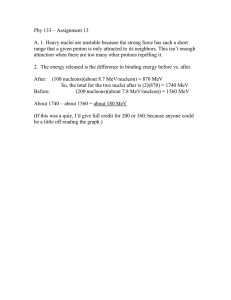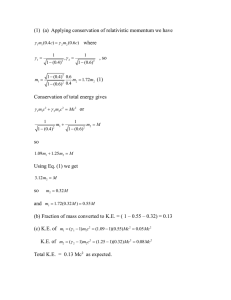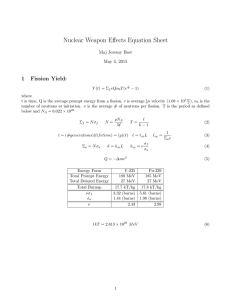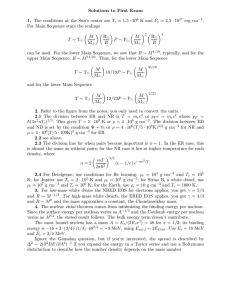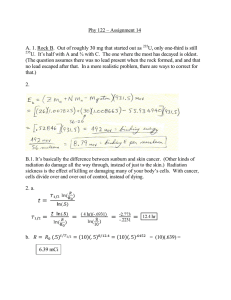Nuclear Structure of Sn Isotopes Using the NuShell Computer Code
advertisement
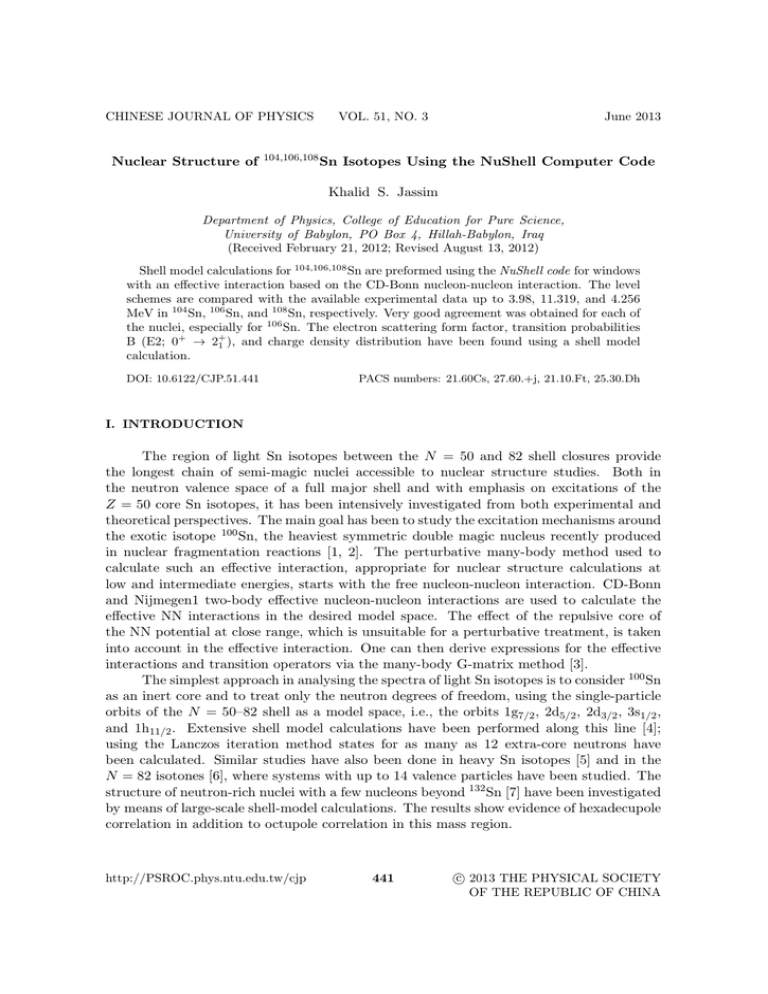
CHINESE JOURNAL OF PHYSICS Nuclear Structure of VOL. 51, NO. 3 104,106,108 Sn June 2013 Isotopes Using the NuShell Computer Code Khalid S. Jassim Department of Physics, College of Education for Pure Science, University of Babylon, PO Box 4, Hillah-Babylon, Iraq (Received February 21, 2012; Revised August 13, 2012) Shell model calculations for 104,106,108 Sn are preformed using the NuShell code for windows with an effective interaction based on the CD-Bonn nucleon-nucleon interaction. The level schemes are compared with the available experimental data up to 3.98, 11.319, and 4.256 MeV in 104 Sn, 106 Sn, and 108 Sn, respectively. Very good agreement was obtained for each of the nuclei, especially for 106 Sn. The electron scattering form factor, transition probabilities B (E2; 0+ → 2+ 1 ), and charge density distribution have been found using a shell model calculation. DOI: 10.6122/CJP.51.441 PACS numbers: 21.60Cs, 27.60.+j, 21.10.Ft, 25.30.Dh I. INTRODUCTION The region of light Sn isotopes between the N = 50 and 82 shell closures provide the longest chain of semi-magic nuclei accessible to nuclear structure studies. Both in the neutron valence space of a full major shell and with emphasis on excitations of the Z = 50 core Sn isotopes, it has been intensively investigated from both experimental and theoretical perspectives. The main goal has been to study the excitation mechanisms around the exotic isotope 100 Sn, the heaviest symmetric double magic nucleus recently produced in nuclear fragmentation reactions [1, 2]. The perturbative many-body method used to calculate such an effective interaction, appropriate for nuclear structure calculations at low and intermediate energies, starts with the free nucleon-nucleon interaction. CD-Bonn and Nijmegen1 two-body effective nucleon-nucleon interactions are used to calculate the effective NN interactions in the desired model space. The effect of the repulsive core of the NN potential at close range, which is unsuitable for a perturbative treatment, is taken into account in the effective interaction. One can then derive expressions for the effective interactions and transition operators via the many-body G-matrix method [3]. The simplest approach in analysing the spectra of light Sn isotopes is to consider 100 Sn as an inert core and to treat only the neutron degrees of freedom, using the single-particle orbits of the N = 50–82 shell as a model space, i.e., the orbits 1g7/2 , 2d5/2 , 2d3/2 , 3s1/2 , and 1h11/2 . Extensive shell model calculations have been performed along this line [4]; using the Lanczos iteration method states for as many as 12 extra-core neutrons have been calculated. Similar studies have also been done in heavy Sn isotopes [5] and in the N = 82 isotones [6], where systems with up to 14 valence particles have been studied. The structure of neutron-rich nuclei with a few nucleons beyond 132 Sn [7] have been investigated by means of large-scale shell-model calculations. The results show evidence of hexadecupole correlation in addition to octupole correlation in this mass region. http://PSROC.phys.ntu.edu.tw/cjp 441 c 2013 THE PHYSICAL SOCIETY ⃝ OF THE REPUBLIC OF CHINA 442 NUCLEAR STRUCTURE OF 104,106,108 SN . . . VOL. 51 On the one hand, the results still deviate significantly from theoretical predictions and, on the other hand, the results indicate a decreasing trend of the energy levels with increasing number of valence particles outside of the 100 Sn core. Experimentally, the nuclear properties of 100 Sn are only indirectly known [7, 8], although its existence has already been confirmed [9–11]. Properties of the 2+ states around 132 Sn have been also studied by Terasaki et al. [6] in a separable quadrupole-plus-pairing model. A large-scale shell model calculation was carried out in the Sn100pn model space with the Sn100pn interaction. This interaction was obtained from a realistic interaction developed by Brown et al. [6] starting with a G matrix derived from the CD-Bonn nucleonnucleon interaction. There are three parts in this interaction, which are the proton-proton (Sn100pp), neutron-neutron (Sn100nn), and proton-neutron (Sn100pn) interactions, along with the coulomb interaction (Sn100co) between the protons. In this work, I am interested in the Sn isotopes only, the neutron-neutron part, i.e., only Sn100nn was relevant for my calculation. The calculations have been performed using doubly magic 100Sn as the core and the valance neutrons (4, 6, and 8) distributed over the single particle-orbits 1s1/2 , 2d5/2 , 2d3/2 , 2g7/2 , and 1h11/2 . The neutron single-particle energies are −8.7167 MeV, −10.6089 MeV, −8.6944 MeV, −10.2893 MeV, and −8.8152 MeV for the 3s1/2 , 2d5/2 , 2d3/2 , 1g7/2 , and 1h11/2 orbitals, respectively [6]. The energy level results and transition probabilities are compared with the experimental levels, as shown in Figures 1, 2, and 3. II. RESULTS AND DISCUSSION II-1. Energy Levels and transition probabilities In order to estimate the energy levels in 104−106−108 Sn, we have performed shell model calculations using the NuShell computer code for windows [12]. We are interested in positive and some negative parity states of 106 Sn with isoscalar Tz =4, for the valance neutron states (1g7/2 , 2d5/2 , 2d3/2 , 3s1/2 , and 1h11/2 ) outside the core 100 Sn. The energy levels spectra of 104 Sn are presented in Figure 1. Our results are reported and plotted in the first column and compared with the experimental spectrum in the second column. It can seen that the agreement is excellent for the states 0+ and 10+ , and there is good agreement for the states 2+ , 4+ , and 8+ in comparison with the experimental results taken from Ref. [13]. The calculated energy levels in the 106 Sn CD-Bonn effective interaction are compared with the experimental data, as shown in Figure 2. The agreement is excellent for the + + + + + + Jπ = 0+ 1 , 41 , 61 , 81 , 102 , 111 , and 221 states in comparison with the data from Ref. [14]. Three energy levels with negative parity states have been calculated for 106 Sn, as shown in − Figure 2. These theoretical values are 4.456 MeV for the 11− 1 state, 5.426 MeV for the 141 − state, and 6.108 MeV for the 151 state, and the absolute differences from the experimental data [14] are 1.087, 2.172, and 1.277 MeV, respectively. The calculation of the energy levels for negative parity starts to deviate from the experimental values, and this reflects the inadequacy of the model space. More negative parity results for the Sn isotopes will be published in a forthcoming paper; also researchers are invited to calculate these levels VOL. 51 KHALID S. JASSIM 443 using another effective interaction, such as the delta interaction or modified surface delta interaction. Figure 3 shows theoretical and experimental values for the energy levels of 108 Sn, the present results on the energy levels agree well with the experimental data [15] at 0+ , 2+ 1, + + + , 3 , and 8 . , 4 6+ 3 1 2 1 The transition probabilities B (E2; 0+ → 2+ 1 ) results are compared with the experimental data in Table I. It can be seen that the theoretical B (E2) values reproduce the data quite well. FIG. 1: Energy levels of 104 Sn. Experimental data from Ref. [14] are compared the[shell model Sn. Experimental data fromtoref. results with the CD-Bonn effective interaction. effective interaction. 444 NUCLEAR STRUCTURE OF 104,106,108 SN . . . VOL. 51 FIG. 2: Energy levels of 106 Sn. Experimental data from Ref. [15] are compared to compared the shell model ] are to shell results with the CD-Bonn effective interaction. II-2. Electron Scattering Form Factors The longitudinal and transverse electron scattering form factors for 104 Sn and 106 Sn are calculated with the residual interaction being based on the CD-Bonn renormalized G 104 Sn and 10+ (1.04 MeV), and matrix elements for different states: 2+ 1 (1.105 MeV) for 1 106 Sn. 4+ (2.193 MeV) for 1 Figures (4) and (5) show the C2 and E2 form factors, respectively, for the transition + from 0+ 1 to 21 with excitation energy 1.495 MeV. From Figure 4, we note that three maxi- 4 VOL. 51 KHALID S. JASSIM 445 FIG. 3: Energy levels of 108 Sn. Experimental data from Ref. [16] are compared to the shell model results with the CD-Bonn effective interaction. data from ref. [16] are compared mum diffractions for electrons scattered by. Experimental the charge distribution and current inside the −1 −1 −1 nucleus at the momentum transfers q = 0.5 fm , 1.2 fm , and 1.7 fm . From Figure 5, we note two maximum diffractions at the momentum transfers q = 0.6 fm−1 and 1.6 fm−1 . + 106 sn are shown The C2 form factors for the transition from 8+ 1 to 101 at 1.04 MeV for 5 446 NUCLEAR STRUCTURE OF 104,106,108 SN . . . VOL. 51 q (fm-1) FIG. 4. The Coulomb (C2) form factors for the transition to the 2 + (1.495 MeV) FIG. 4: The Coulomb (C2) form factors for the transition to the 2+ 1 (1.495 MeV) state in + 104 Sn. + E2 (01 to 21 ) 1.495 MeV 4 q (fm-1) FIG. 5. The transvers (E2) form factors for the transition to the 2 + FIG. 5: The transverse (E2) form factors for the transition to the 2+ 1 (1.495 MeV) states in 104 Sn. KHALID S. JASSIM 447 |F(q)|2 VOL. 51 q (fm-1) FIG. 6. The Coulomb (C2) form factors for the transition to the 10 + (1.04 MeV) FIG. 6: The Coulomb (C2) form factors for the transition to the 10+ 1 (1.04 MeV) states in 6 q (fm-1) FIG. 7. The longitudinal (C4) form factors for the 4 FIG. 7: The longitudinal (C4) form factors for the + (2.193 MeV) state in 106Sn. 4+ 1 (2.193 MeV) state in 106 Sn. 106 Sn. 448 NUCLEAR STRUCTURE OF 104,106,108 SN . . . VOL. 51 FIG. 8: The longitudinal (C2) form factors for the 2+ MeV) state in 1 (1.37 (1.37 MeV) state in 8 FIG. 9: Dependence of the CDD on the r (fm) for 104 Sn. 108 Sn. VOL. 51 KHALID S. JASSIM 449 106 FIG. 10: Dependence of the CDD on r (fm) for Sn. Sn. 10 on the r (fm) for 108Sn FIG. 11: Dependence of the CDD on r (fm) for 108 Sn. 450 NUCLEAR STRUCTURE OF 104,106,108 SN . . . VOL. 51 TABLE I: Comparison of the B (E2; 0+ → 2+ 1 ) values, obtained from the shell model calculations with the experimental values in e2 b2 for even Sn isotopes. The experimental data have been taken from Ref. [17, 18] Isotope Exp. Present work 104 Sn — 0.0849 106 Sn 0.240 0.3504 108 Sn 0.230 0.1979 in Figure 6. The maximum diffraction for the scattered electrons are at the momentum transfer values q = 0.6 fm−1 , 1.4 fm−1 , and 2 fm−1 . The minimum diffraction values are at q = 1 fm−1 and 1.8 fm−1 . As mentioned previously, the experimental data are unavailable at the literature in the mean time; therefore, these results cannot be comparable with the experimental results. Figure 7 represents the relation between the C4 form factors as a function of momen+ tum transfer for the state from 0+ 1 to 41 at excitation energy 2.193 MeV. The diffraction maxima for the scattered electrons are at the momentum transfer values q = 1 fm−1 , 1.8 fm−1 , and 2.4 fm−1 . The maximum diffraction values are at q = 1 fm−1 and 2.2 fm−1 . The minimum diffraction values at q = 1.4 fm−1 and 2.2 fm−1 . 108 Sn is shown in The longitudinal (C2) form factor for the 2+ 1 (1.37 MeV) state of −1 −1 Figure 8. The maximum diffraction values are at q = 0.6 fm , 1.3 fm , and 1.9 fm−1 . The minimum diffraction for scattered electrons are at the momentum transfer values q = 1.1 fm−1 and 1.6 fm−1 . II-3. Charge density distribution (CDD) The dependence of the CDD ρ (Ze.fm−3 ) on r (fm) for 104 Sn, 106 Sn, and 108 Sn nuclei are displayed in Figures 9, 10, and 11, respectively. We note that the CDD at the centre of the nucleus (r = 0 fm) for 104 Sn, 106 Sn, and 108 Sn are 7.32 × 10−2 (Ze.fm−3 ), 6.81 × 10−2 (Ze.fm−3 ), and 6.21×10−2 (Ze.fm−3 ), respectively; they began to increase up to 7.48×10−2 (Ze.fm−3 ) at r = 0.8 fm, 7.54 × 10−2 (Ze.fm−3 ) at r = 3.2 fm, and 6.87 × 10−2 (Ze.fm−3 ) at r = 3.6 fm, respectively. After that the CDD began decreasing down to zero at r = 4.8 fm, 8 fm, and 8.4 fm, respectively. III. SUMMARY The nuclear structure (energy level, transition probabilities, form factors, and CDD) calculations with an effective interaction based on the CD-Bonn nucleon-nucleon interaction were performed for 104,106,108 Sn using the NuShell code for windows. The energy levels results are compared with the experimental levels. The agreement between the calculated and experimental excitation energies up to 3.98, 11.319, and 4.256 MeV in 104 Sn, 106 Sn, VOL. 51 KHALID S. JASSIM 451 and 108 Sn, respectively, are very good. The electron scattering form factor r and the charge density distribution are found using the shell model calculation. These results are not compared with the experimental results, because the experimental data are unavailable in the literature at the present time. References [1] [2] [3] [4] [5] [6] [7] [8] [9] [10] [11] [12] [13] [14] [15] [16] [17] [18] M. Lewitowicz et al., Phys. Lett. B332, 20 (1994). R. Schneider et al., Zeit. Phys. A348, 241 (1994). M. Hjorth-Jensen et al., Phys. Rep. 261, 125 (1995). T. Engeland, M. Hjorth-Jensen, A. Holt, and E. Osnes, Phys. Scripta T56, 58 (1995). T. Engeland, M. Hjorth-Jensen, A. Holt, and E. Osnes, in Proceedings of the International Workshop on Double-beta Decay and Related Topics, eds. H. V. Kapdor and S. Stoica (World Scientific, Singapore, 1996), p. 421. B. A. Brown et al., Phys. Rev. C 71, 044317 (2005). H. Jin et al., Phys. Rev. C 84, 044324 (2011). M. Lipoglavsek et al., Phys. Lett. B440, 246 (1998). M. G’orska et al., Phys. Rev. C 58, 108 (1998). A. Blazhev et al., Phys. Rev. C 69, 64304 (2004). M. Lewitowicz et al., Phys. Lett. B332, 20 (1994). R. Schneider et al., Z. Phys. A348, 241 (1994). B. A. Brown and W. D. M. Rae, MSU-NSCL report (2007). J. Blachot, Nuclear Data Sheets 108, 2035 (2007). doi: 10.1016/j.nds.2007.09.001 D. D. Frenne and A. Negret, Nucl. Data Sheets 109, 943 (2008). doi: 10.1016/j.nds.2008.03.002 J. Blachot, Nucl. Data Sheets 91, 135 (2000). doi: 10.1006/ndsh.2000.0017 A. Banu et al., Phys. Rev. C 72, 061305(6) (2005). C. Vaman et al., Phys. Rev. Lett. 99, 162501 (2007).


